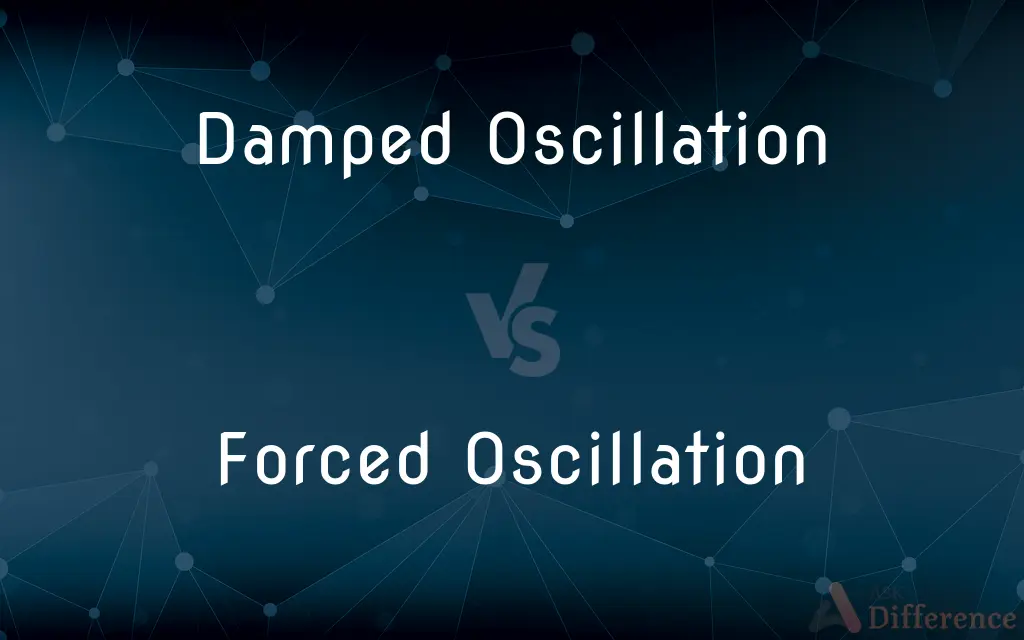Damped Oscillation vs. Forced Oscillation — What's the Difference?
By Tayyaba Rehman — Published on November 8, 2023
Damped Oscillation is an oscillation that decreases in amplitude over time due to energy loss, e.g., friction or resistance, while Forced Oscillation is an oscillation that occurs under the influence of an external periodic force.

Difference Between Damped Oscillation and Forced Oscillation
Table of Contents
ADVERTISEMENT
Key Differences
In Damped Oscillation, the motion progressively reduces due to resistive forces such as friction or air resistance. Damped Oscillation naturally attenuates its amplitude over time, and the system gradually comes to rest. Conversely, Forced Oscillation indicates a persistent, externally driven oscillation where an object is forced to vibrate by an external periodic force, continually feeding energy into the system. Thus, the system oscillates with a specific frequency - the forcing frequency.
The crucial discrepancy between Damped Oscillation and Forced Oscillation emerges in the energy behavior throughout the oscillation process. In Damped Oscillation, the system inherently loses energy, causing the amplitude of oscillation to diminish and eventually cease. On the other hand, Forced Oscillation is an occurrence where external energy systematically intervenes, maintaining or altering the amplitude and frequency of the oscillation.
A system undergoing Damped Oscillation ultimately loses its kinetic and potential energy to resistive forces, causing the oscillation to subside and halt. In contrast, Forced Oscillation is determined by the external force that is applied, compelling the system to oscillate at a particular frequency, often resulting in a steady-state oscillation that can be sustained indefinitely, given the continuous input of external energy.
Analyzing Damped Oscillation, one discerns that without any external interference, the oscillating object, such as a pendulum, would eventually stop. This termination occurs due to the natural resistance present in the medium through which it oscillates or through an internal mechanism. In direct contrast, the sustainability of Forced Oscillation, such as a child perpetually swinging a swing, can perpetually uphold the amplitude and frequency, avoiding the natural dissipation of energy seen in damped scenarios.
The interaction with external forces vividly distinguishes Damped Oscillation from Forced Oscillation. Damped Oscillation gradually ceases in the absence of an external force, while Forced Oscillation necessitates an external force to not only begin but also sustain its motion. The dichotomy presents an inherent contrast in energy dynamics and sustainability between the two oscillatory motions.
ADVERTISEMENT
Comparison Chart
Energy Source
Intrinsic; loses energy over time
External; continuously supplied
Amplitude Behavior
Decreases gradually
Can be sustained or varied
Dependency
Independent of external forces
Dependent on external periodic force
Duration
Ceases eventually
Can be indefinite
Frequency Source
Natural frequency of the system
Frequency of the external force
Compare with Definitions
Damped Oscillation
Damped Oscillation can be overdamped, critically damped, or underdamped.
The critically damped oscillation ensured the door closed swiftly without bouncing back.
Forced Oscillation
Forced Oscillation is sustained by an external periodic force.
The forced oscillation of the swing continued as the child kept pushing it.
Damped Oscillation
Damped Oscillation involves a decrease in amplitude over time.
The swinging pendulum slowly came to a halt due to damped oscillation.
Forced Oscillation
Forced Oscillation can impose sustained or varied amplitude and frequency.
The machine forced oscillation upon the bridge, causing it to vibrate dangerously.
Damped Oscillation
Damped Oscillation ultimately leads to a cessation of motion.
The damped oscillation of the spring ensured it didn’t oscillate endlessly.
Forced Oscillation
The oscillation adopts the frequency of the external force in Forced Oscillation.
The tuning fork experienced forced oscillation at the frequency of the applied sound wave.
Damped Oscillation
In Damped Oscillation, resistive forces curtail the vibrational movement.
The damped oscillation of the guitar string gradually silenced the note.
Forced Oscillation
It does not necessarily settle into a natural frequency during Forced Oscillation.
The forced oscillation imposed a new frequency on the system, disregarding its natural rhythm.
Damped Oscillation
The process inherently loses energy during Damped Oscillation.
The oscillating fan stopped swinging back and forth due to the damped oscillation.
Forced Oscillation
Forced Oscillation can overcome damping by continuously supplying energy.
Despite air resistance, the forced oscillation of the pendulum persisted with external pushes.
Common Curiosities
How does damping affect Damped Oscillation?
Damping in Damped Oscillation causes a gradual decrease in amplitude and velocity until motion ceases.
Can Damped Oscillation cease completely?
Yes, Damped Oscillation will eventually cease as energy dissipates and amplitude reduces to zero.
How is Forced Oscillation maintained?
Forced Oscillation is maintained through the continuous application of an external periodic force.
What is an example of Damped Oscillation in everyday life?
A simple pendulum gradually stopping its swing due to air resistance is an example of Damped Oscillation.
Can Forced Oscillation occur without external intervention?
No, Forced Oscillation inherently relies on an external periodic force to sustain it.
What is a practical example of Forced Oscillation?
A child persistently pushing a swing to keep it moving illustrates Forced Oscillation.
Can Forced Oscillation alter a system’s natural frequency?
Yes, Forced Oscillation can impose its frequency, overriding the system’s natural frequency.
What defines Damped Oscillation in a system?
Damped Oscillation is characterized by a reduction in amplitude over time due to resistive forces.
Are there any risks associated with Forced Oscillation in engineering?
Yes, Forced Oscillation can induce harmful resonances, causing mechanical failure if the frequency aligns with the system’s natural frequency.
Is energy constantly supplied in Forced Oscillation?
Yes, Forced Oscillation necessitates a continuous input of external energy to persist.
How can Forced Oscillation impact a mechanical system?
Forced Oscillation can induce vibrations, potentially leading to resonance and structural stress in a system.
In which scenarios is Damped Oscillation desirable?
Damped Oscillation is often desirable in systems like vehicle suspension or electronics to prevent prolonged vibrations and ensure stability.
What happens in the absence of damping in a Damped Oscillation?
Without damping, Damped Oscillation would become sustained oscillation, continuing indefinitely.
What determines the rate of energy loss in Damped Oscillation?
The level of damping and resistance in the medium determines the energy loss rate in Damped Oscillation.
Can Damped Oscillation occur in electrical circuits?
Yes, Damped Oscillation can occur in electrical circuits through resistor-capacitor (RC) or resistor-inductor (RL) networks.
Share Your Discovery

Previous Comparison
Narrative Essay vs. Descriptive Essay
Next Comparison
Surname vs. Last NameAuthor Spotlight
Written by
Tayyaba RehmanTayyaba Rehman is a distinguished writer, currently serving as a primary contributor to askdifference.com. As a researcher in semantics and etymology, Tayyaba's passion for the complexity of languages and their distinctions has found a perfect home on the platform. Tayyaba delves into the intricacies of language, distinguishing between commonly confused words and phrases, thereby providing clarity for readers worldwide.












































